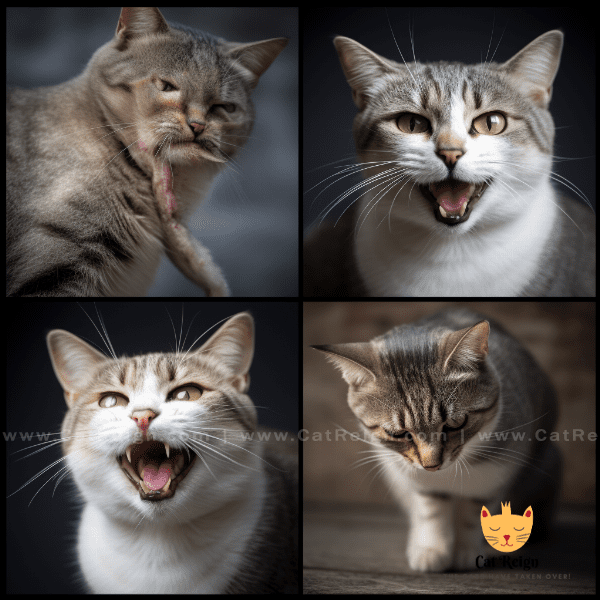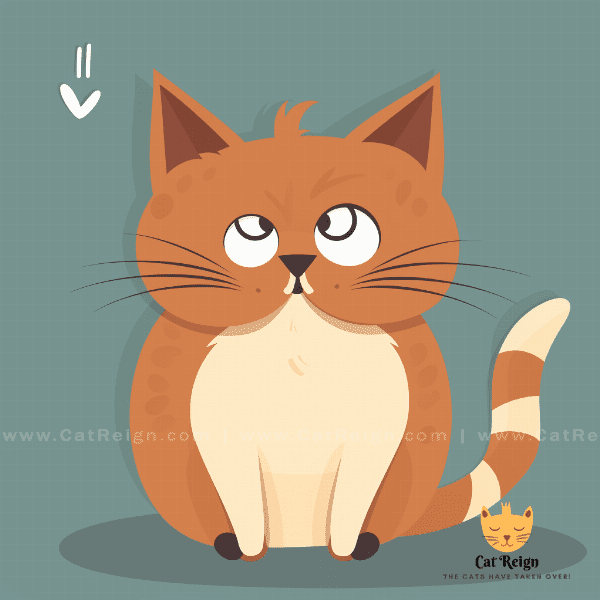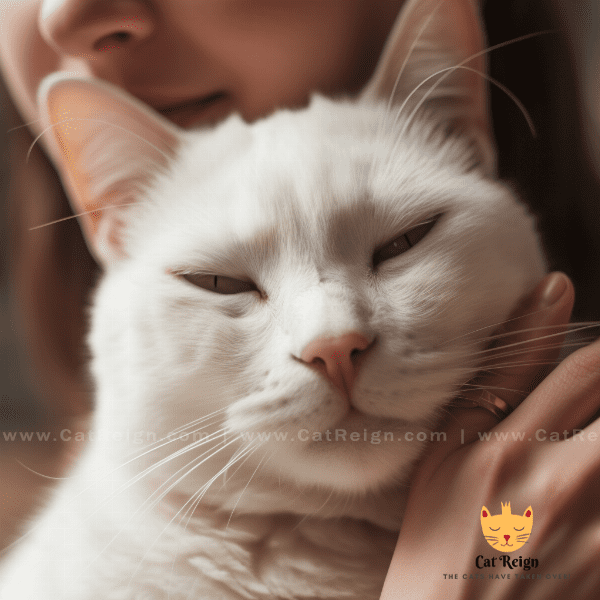Table of Contents
- What is Cat Hissing and Why Do Cats Hiss?
- Common Triggers for Cat Hissing
- Body Language: How to Read Your Cat’s Hissing
- Is Cat Hissing Always Aggressive?
- How to React When Your Cat Hisses
- Reducing Cat Hissing through Behavior Modification
- When to Seek Professional Help for Cat Aggression
- Other Forms of Feline Communication: Meowing, Purring, and More
- Tips for Preventing Cat Hissing in Multi-Cat Households
- Conclusion: Nurturing a Happy and Healthy Relationship with Your Cat.
What is Cat Hissing and Why Do Cats Hiss?
Cats are known for their distinct hissing sound. It is a common behavior among felines that can signify various emotions and feelings. Hissing is a way for cats to express their displeasure, fear, and even aggression. But what is Cat hissing, and why do cats hiss? In this section, we will take a closer look at this behavior and what it means.
The Definition of Cat Hissing
Hissing is a warning sound made by cats that indicates they are feeling threatened or frightened. It is an instinctual response that has evolved over time to protect cats from danger. When a cat hisses, it is telling you to back off or risk getting attacked.
Reasons Why Cats Hiss
Cats hiss for a variety of reasons, and it’s important to understand what your cat is trying to communicate. One of the most common reasons cats hiss is because they are scared or feel threatened. For example, if a stranger comes into their territory or if they feel like their personal space is being invaded, they may hiss to warn the intruder to stay away.
Another reason cats hiss is because they are in pain. If your cat is injured or experiencing discomfort, they may hiss to let you know that they are not feeling well. Additionally, cats may hiss if they feel cornered or trapped and have no escape route.
Understanding Your Cat’s Body Language
Cat hissing is often accompanied by other body language cues that can give you clues about what your cat is feeling. For example, a cat that is hissing may have their ears flattened against their head, their body tense and ready to pounce, and their tail flicking back and forth rapidly.
Understanding your cat’s body language can help you identify the reason why they are hissing and determine the appropriate response. For instance, if your cat is hissing because they are scared, it’s best to give them some space and avoid any sudden movements that could make them feel more threatened.
In conclusion, cat hissing is a natural behavior that serves as a warning to potential threats. Understanding why cats hiss and what they are trying to communicate can help you build a stronger bond with your feline companion and respond appropriately to their needs. By respecting your cat’s boundaries and body language cues, you can help prevent unnecessary stress and ensure a happy and healthy relationship.

Common Triggers for Cat Hissing
Cat hissing is a common behavior that can be triggered by various situations and stimuli. By understanding these triggers, you can help prevent unnecessary stress for your cat and minimize the chances of them hissing. In this section, we will explore some of the most common triggers for cat hissing.
Territorial Issues
Cats are territorial animals and can be very possessive of their space. If another animal or person encroaches on their territory, they may hiss to warn them to stay away. This behavior is particularly common among cats that live in multi-cat households, where competition for resources and territory can be high.
Overstimulation
Cats have a limit to the amount of physical and sensory stimulation they can handle before becoming overstimulated. When a cat becomes overstimulated, they may hiss or even lash out as a way to protect themselves. Overstimulation can be caused by excessive petting, loud noises, or even too much visual stimulation.
Aggression
In conclusion, cat hissing can be triggered by various situations and stimuli. By understanding these triggers and being aware of your cat’s body language and behavior, you can help prevent unnecessary stress and ensure a happy and healthy relationship with your feline companion.

Body Language: How to Read Your Cat’s Hissing
Cats are known for their complex body language, and understanding their cues can help you interpret their hissing behavior more accurately. In this section, we will explore how to read your cat’s hissing behavior and what their body language can tell you.
Tail
A cat’s tail can also reveal a lot about their emotional state. When a cat is hissing, their tail is likely to be twitching rapidly or tucked between their legs as a sign of fear or anxiety. However, if their tail is held upright and bushy, they may be hissing out of aggression or territoriality.
Body Posture
A cat’s body posture can also give clues about their hissing behavior. When a cat is hissing out of fear or anxiety, their body is likely to be hunched and tense, with their fur standing on end. However, if they are hissing out of aggression, their body may be arched and ready to pounce.
Facial Expressions
Cats can communicate a lot through their facial expressions. When a cat is hissing, their face may be tense and their pupils dilated as a sign of fear or anxiety. However, if they are hissing out of aggression, their face may be contorted with their ears back and their teeth bared.
By observing your cat’s body language when they hiss, you can better understand what they are trying to communicate. If your cat is hissing out of fear or anxiety, it’s best to give them some space and try to identify the cause of their distress. If they are hissing out of aggression, it’s important to address the behavior and seek professional help if necessary.
In conclusion, reading your cat’s body language can help you interpret their hissing behavior and respond appropriately. By observing their ears, tail, body posture, and facial expressions, you can better understand your cat’s emotional state and build a stronger bond with your feline companion.

Is Cat Hissing Always Aggressive?
While cat hissing is often associated with aggression, it’s important to understand that this behavior can also signify other emotions and feelings. In this section, we will explore whether cat hissing is always aggressive and what other reasons may be behind this behavior.
Fear and Anxiety
Cat hissing can be a sign of fear and anxiety, particularly if the cat is feeling threatened or uncomfortable. When a cat hisses out of fear, they are trying to protect themselves and communicate to their surroundings that they are not feeling safe. In this case, it’s important to identify the cause of their fear and help them feel more secure.
Pain or Discomfort
Cats may also hiss when they are in pain or discomfort. For example, if they have an injury or are experiencing discomfort due to a medical condition, they may hiss as a way to communicate their distress. In this case, it’s important to check your cat for any signs of pain and seek veterinary care if necessary.
Overstimulation
Cats can become overstimulated if they receive too much sensory input, such as petting or noise. When a cat becomes overstimulated, they may hiss or even lash out as a way to protect themselves. In this case, it’s important to recognize your cat’s limits and respect their boundaries.
Aggression
Finally, cat hissing can be a sign of aggression, particularly if the cat is feeling threatened or territorial. In this case, it’s important to identify the cause of their aggression and take appropriate steps to address the behavior, such as through behavior modification techniques or professional help.
In conclusion, cat hissing is not always a sign of aggression and can also signify fear, pain, discomfort, or overstimulation. By understanding the reason behind your cat’s hissing behavior, you can respond appropriately and help them feel more comfortable and secure in their environment.

How to React When Your Cat Hisses
Cat hissing can be a challenging behavior to deal with, especially if you are not familiar with what it means. In this section, we will explore how to react when your cat hisses and what steps you can take to minimize the chances of them hissing in the future.
Stay Calm
The first and most important step when your cat hisses is to stay calm. If you react with fear or aggression, you may escalate the situation and cause your cat to feel more threatened. Instead, take a step back and give your cat some space to calm down.
Identify the Cause
The next step is to identify the cause of your cat’s hissing behavior. As we’ve discussed earlier, cats may hiss for various reasons, including fear, pain, discomfort, overstimulation, or aggression. By understanding the underlying cause, you can respond appropriately and address the behavior.
Respond Appropriately
The appropriate response will depend on the cause of your cat’s hissing behavior. For example, if your cat is hissing out of fear, it’s best to give them some space and avoid any sudden movements that could make them feel more threatened. If they are hissing out of pain or discomfort, it’s important to check them for any signs of injury or medical conditions.
Practice Positive Reinforcement
In conclusion, reacting appropriately when your cat hisses can help prevent unnecessary stress and ensure a happy and healthy relationship with your feline companion. By staying calm, identifying the cause, responding appropriately, seeking professional help if necessary, and practicing positive reinforcement, you can help prevent your cat from hissing in the future and build a stronger bond with your feline companion.

Reducing Cat Hissing through Behavior Modification
If your cat is hissing frequently or exhibiting aggressive behavior, behavior modification techniques can be helpful in reducing their hissing behavior. In this section, we will explore some behavior modification techniques that can help reduce cat hissing.
Identify the Trigger
The first step in behavior modification is to identify the trigger that is causing your cat to hiss. Once you have identified the trigger, you can work to eliminate or reduce the stimulus that is causing the behavior. For example, if your cat is hissing out of fear of a particular person or animal, you can gradually introduce them to your cat in a controlled environment to help them feel more comfortable.
Use Positive Reinforcement
Positive reinforcement can be a powerful tool in behavior modification. By rewarding good behavior, such as when your cat is calm and relaxed, you can encourage them to continue exhibiting that behavior. Positive reinforcement can include treats, praise, or playtime with toys.
Create a Safe and Secure Environment
Creating a safe and secure environment can also help reduce your cat’s hissing behavior. Providing your cat with a designated space, such as a comfortable bed or crate, can help them feel more secure and reduce their stress levels. Additionally, providing plenty of toys and playtime can help stimulate your cat and reduce their anxiety.
.

When to Seek Professional Help for Cat Aggression
While some hissing behavior in cats can be normal, persistent or extreme aggression can be a cause for concern. In this section, we will explore when to seek professional help for cat aggression and what steps you can take to address the behavior.
Extreme Aggression
If your cat’s aggression is extreme, such as frequent attacks or serious injuries, it’s important to seek professional help immediately. Extreme aggression can be dangerous to both you and your cat and may require immediate intervention from a professional.
Other Behavioral Issues
If your cat is exhibiting other behavioral issues, such as excessive meowing or destructive behavior, it may be a sign of underlying behavioral issues that require attention. A veterinarian or animal behaviorist can help identify the cause of the behavior and provide guidance on how to address it effectively.
In conclusion, seeking professional help for cat aggression can be necessary in certain situations. If your cat’s aggression is persistent, extreme, or accompanied by signs of stress or anxiety, it’s important to seek help from a veterinarian or animal behaviorist. By addressing the underlying cause of the aggression and working with a professional, you can help prevent unnecessary stress and ensure a happy and healthy relationship with your feline companion.

Other Forms of Feline Communication: Meowing, Purring, and More
While hissing is a common form of feline communication, cats use a variety of other vocalizations and body language to express themselves. In this section, we will explore other forms of feline communication and what they may signify.
Meowing
Meowing is perhaps the most well-known form of feline communication. Cats may meow to indicate that they are hungry, in need of attention, or want to communicate with their owners. Meows can vary in pitch, volume, and duration, and understanding your cat’s specific meowing patterns can help you understand their needs.
Purring
Purring is another common form of feline communication that is often associated with contentment and relaxation. However, cats may also purr when they are anxious or in pain, as a way to self-soothe. Paying attention to your cat’s body language and the context in which they are purring can help you understand what they are trying to communicate.
Body Language
Cats use body language to communicate a lot of information, such as their emotional state, intentions, and needs. For example, a relaxed and open body posture can indicate that your cat is feeling comfortable and at ease, while a tense and hunched posture can indicate that they are feeling threatened or scared.
Vocalizations
Cats use a variety of other vocalizations, such as growls, hisses, and yowls, to communicate different emotions and needs. Growls and yowls are often associated with aggression or territoriality, while hisses are often associated with fear or discomfort.
Scent Marking
Cats also use scent marking as a form of communication. They may rub their heads against objects or spray urine to mark their territory or communicate with other cats. Understanding your cat’s scent marking behavior can help you understand their needs and preferences.
In conclusion, cats use a variety of forms of communication, including meowing, purring, body language, vocalizations, and scent marking. By paying attention to your cat’s specific communication patterns and body language, you can better understand their needs and build a stronger bond with your feline companion.

Tips for Preventing Cat Hissing in Multi-Cat Households
Living with multiple cats can be challenging, especially if they don’t get along. Hissing behavior can be a sign of aggression or territoriality, and it’s important to take steps to prevent it from happening. In this section, we will explore some tips for preventing cat hissing in multi-cat households.
Introduce Cats Slowly
When introducing a new cat to a multi-cat household, it’s important to do so slowly and in a controlled environment. This can help prevent territorial behavior and reduce the chances of hissing. Allow the cats to sniff each other through a closed door and gradually introduce them to each other in a supervised setting.
Provide Plenty of Resources
Providing plenty of resources, such as food bowls, litter boxes, and scratching posts, can help reduce competition and prevent territorial behavior. Make sure to provide enough resources for each cat and place them in separate areas to prevent conflict.
Playtime and Exercise
Regular playtime and exercise can also help reduce hissing behavior in multi-cat households. Playtime can help release pent-up energy and reduce stress levels, which can in turn reduce the chances of hissing.
Separate Spaces
Providing separate spaces for each cat can also help prevent hissing behavior. This can include separate sleeping areas, hiding spots, and even separate rooms if necessary. This can help reduce competition and prevent territorial behavior.
Seek Professional Help
If your cats are consistently hissing and exhibiting aggressive behavior towards each other, it may be necessary to seek professional help. A veterinarian or animal behaviorist can help identify the cause of the behavior and provide guidance on how to address it effectively.
In conclusion, preventing hissing behavior in multi-cat households requires patience, understanding, and a willingness to provide for each cat’s needs. By introducing cats slowly, providing plenty of resources, encouraging playtime and exercise, providing separate spaces, and seeking professional help if necessary, you can help prevent unnecessary stress and ensure a happy and healthy relationship with your feline companions.

Conclusion: Nurturing a Happy and Healthy Relationship with Your Cat.
Understanding your cat’s behavior, including hissing, can help you build a stronger bond with your feline companion and create a happy and healthy relationship. In this article, we have explored what cat hissing is and why cats hiss, common triggers for hissing behavior, how to read your cat’s body language, how to react when your cat hisses, and techniques for reducing hissing behavior through behavior modification.
We have also discussed other forms of feline communication, tips for preventing hissing behavior in multi-cat households, and when to seek professional help for cat aggression. By taking the time to understand your cat’s specific communication patterns and needs, you can help prevent unnecessary stress and ensure a happy and healthy relationship with your feline companion.
Remember, cats are unique individuals with their own personalities and preferences. Paying attention to your cat’s behavior, providing for their needs, and seeking professional help when necessary can help prevent hissing behavior and create a strong bond between you and your feline companion.
Thank you for taking the time to read this article, and we hope you have found it informative and helpful in nurturing a happy and healthy relationship with your cat.




